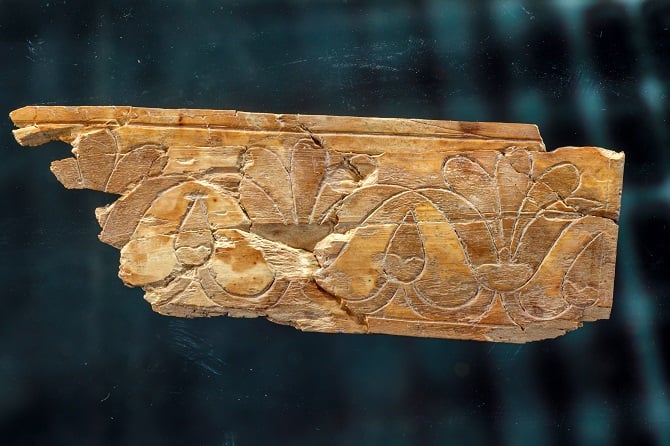It is worth noting that ivory was considered one of the most expensive raw materials in the ancient world, even more than gold. The ivories were found among the ruins of a large palatial building that was in use when Jerusalem was at the height of its power (the 8th and 7th centuries BCE). Scholars believe that the decorated ivories were inlaid in wooden furnishings that were used by the residents of the building – people of means, influence, and power, possibly high government officials or priests.
According to the excavation directors, Prof. Yuval Gadot of Tel Aviv University’s Department of Archaeology and Near Eastern Cultures and Dr. Yiftah Shalev of the Israel Antiquities Authority, “To date, we only knew of decorated ivories from the capitals of the great kingdoms in the First Temple period, such as Nimrud, the capital of Assyria, or Samaria, the capital of the Israelite Kingdom. Now, for the first time, Jerusalem joins these capitals.”
“Jerusalem’s importance and centrality in the region during the First Temple period was already known to us, but the new find illustrates how important it was and places it in the same league as the capitals of Assyria and Israel. The discovery of the ivories is a step forward in understanding the political and economic status of the city as part of global management and economy system.”
Ivory is mentioned only a few times in the Bible, always in connection with royalty or great wealth – the description of the throne of King Solomon (I Kings 10:18); an ivory palace built by King Ahab in Samaria (1 Kings 22:39); and the prophet Amos’s castigation of Israelite nobility: “They lie on ivory beds, lolling on their couches” (Amos 6:4).
The impressive building in which the ivories were unearthed was devastated in a huge fire, apparently during the Babylonian destruction of Jerusalem in 586 BCE, and the ivories were discovered smashed into tiny pieces and burnt. During the excavation, as part of the wet-sieving project in Emek Tzurim National Park, no fewer than 1,500 fragments were found.
It was only after a unique restoration project, led by conservator Orna Cohen, together with Ilan Naor from the Israel Antiquities Authority, that the plaques were restored, and the richness of the collection was revealed. “At the end of the process of joining and ‘fusing’ hundreds of the fragments, we were able to understand that the assemblage includes remnants of at least 12 small square plaques, about 5 cm x 5 cm, at most 0.5 cm thick, which were originally inlaid in wooden furniture,” Cohen and Naor said.
The ivories were not the only luxury items found at the site. A seal made of agate (a semi-precious stone), jars that had held vanilla-spiced wine, decorated stone objects, and wooden items that were apparently part of other large wooden furnishings, were also unearthed.
Adorned ivories are among the most prominent and rare findings in archaeological discoveries. Their prestige stems from the source of the ivory. Microscopic testing by Harel Shohat of the University of Haifa revealed that they were made from elephant tusks.
“The prestige of ivory is also associated with the great skill required to work with it and create decorations,” Prof. Gadot and Dr. Shalev explain. “The collection of ivory discovered in the City of David was probably imported, and originally made by artisans in Assyria. The ivories may have come to Jerusalem as a gift from Assyria to Jerusalem’s nobility. After comparing them to intact items appearing in wall reliefs from the palace of the Assyrian King Sennacherib at Nineveh, we suggested restoring the Jerusalemite ivory plaques and setting them into a bed canopy, that we may imagine them situated on the top floor of the ornate structure.
The decorations on most of the ivories are uniform and include a frame, on which rosettes and tendrils are engraved, with a stylish tree at the center. Other plaques were adorned with lotus flowers and a geometric pattern. According to Dr. Ido Koch and Reli Avisar of Tel Aviv University, who studied the objects, the rosette and the tree were popular symbols in the repertoire of Mesopotamia and in other cultural centers. Ivory objects with similar decorations were discovered in the collection of ivories from Samaria, and in more distant palaces, such as Nimrud and Khorsabad in the heart of the Assyrian Empire.
The Judahite elite adopted these symbols during the period that the kingdom was under the rule of the Assyrian Empire (from the second half of the 8th century BCE). Interestingly, these three symbols served during the same period in Judah as symbols of the kingdom, both on stone items that adorned opulent buildings (decorated stone capitals discovered in Jerusalem at Armon Hanatziv, at Ramat Rachel and Emek Refaim), as well as seals used in the royal administration (rosette seals were used to stamp jars, marking their contents as belonging to the royal household).
Even more interesting is to see that motifs of animals and mythological human figures that appear on ivory items discovered in Samaria, Nimrud, and other centers do not exist in the Jerusalem collection. “It’s possible that what we have here is evidence of a cultural choice by the elite in Jerusalem as to which global symbols to adopt and which to reject,” the scholars said.
According to Eli Eskozido, the director of the Israel Antiquities Authority: “The excavations in the City of David never cease to amaze. This time, with delicate and exciting work by conservators and researchers, we received a glimpse into the daily lives of people who lived here thousands of years ago. These discoveries breathe life into the ancient stones. The realization that the material wealth held by the social elites in Jerusalem during the First Temple period did not fall short of, and perhaps even surpassed that of other centers of power in the ancient Near East, testifies to the status of Jerusalem and its importance at that time.”







